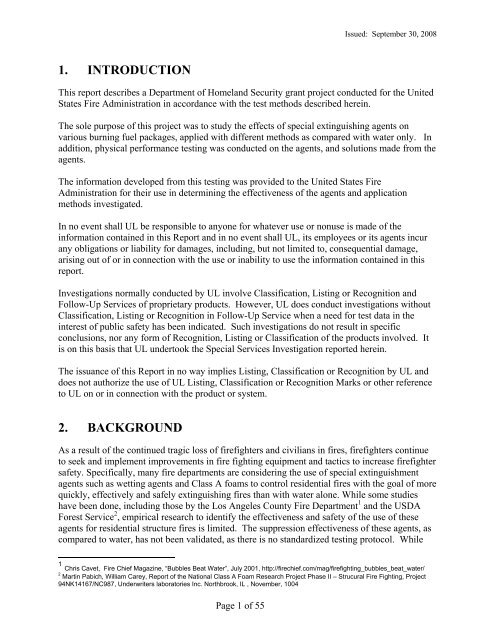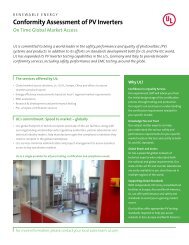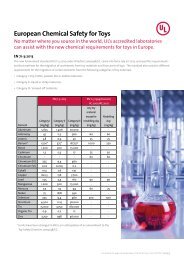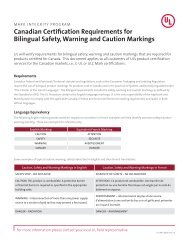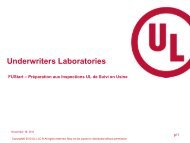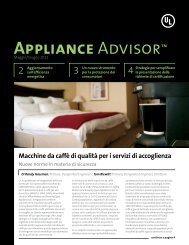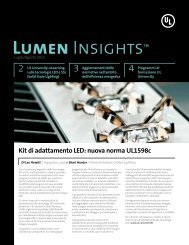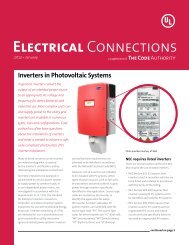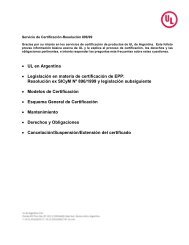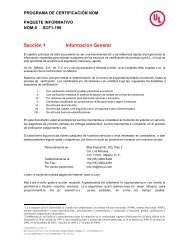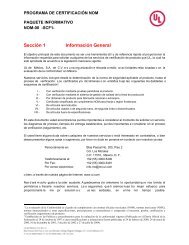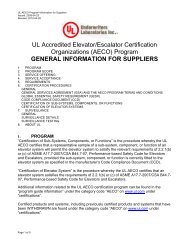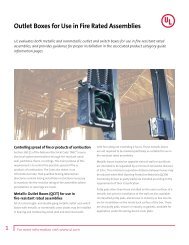Performance of Special Extinguishment Agents for ... - UL.com
Performance of Special Extinguishment Agents for ... - UL.com
Performance of Special Extinguishment Agents for ... - UL.com
You also want an ePaper? Increase the reach of your titles
YUMPU automatically turns print PDFs into web optimized ePapers that Google loves.
Issued: September 30, 2008<br />
1. INTRODUCTION<br />
This report describes a Department <strong>of</strong> Homeland Security grant project conducted <strong>for</strong> the United<br />
States Fire Administration in accordance with the test methods described herein.<br />
The sole purpose <strong>of</strong> this project was to study the effects <strong>of</strong> special extinguishing agents on<br />
various burning fuel packages, applied with different methods as <strong>com</strong>pared with water only. In<br />
addition, physical per<strong>for</strong>mance testing was conducted on the agents, and solutions made from the<br />
agents.<br />
The in<strong>for</strong>mation developed from this testing was provided to the United States Fire<br />
Administration <strong>for</strong> their use in determining the effectiveness <strong>of</strong> the agents and application<br />
methods investigated.<br />
In no event shall <strong>UL</strong> be responsible to anyone <strong>for</strong> whatever use or nonuse is made <strong>of</strong> the<br />
in<strong>for</strong>mation contained in this Report and in no event shall <strong>UL</strong>, its employees or its agents incur<br />
any obligations or liability <strong>for</strong> damages, including, but not limited to, consequential damage,<br />
arising out <strong>of</strong> or in connection with the use or inability to use the in<strong>for</strong>mation contained in this<br />
report.<br />
Investigations normally conducted by <strong>UL</strong> involve Classification, Listing or Recognition and<br />
Follow-Up Services <strong>of</strong> proprietary products. However, <strong>UL</strong> does conduct investigations without<br />
Classification, Listing or Recognition in Follow-Up Service when a need <strong>for</strong> test data in the<br />
interest <strong>of</strong> public safety has been indicated. Such investigations do not result in specific<br />
conclusions, nor any <strong>for</strong>m <strong>of</strong> Recognition, Listing or Classification <strong>of</strong> the products involved. It<br />
is on this basis that <strong>UL</strong> undertook the <strong>Special</strong> Services Investigation reported herein.<br />
The issuance <strong>of</strong> this Report in no way implies Listing, Classification or Recognition by <strong>UL</strong> and<br />
does not authorize the use <strong>of</strong> <strong>UL</strong> Listing, Classification or Recognition Marks or other reference<br />
to <strong>UL</strong> on or in connection with the product or system.<br />
2. BACKGROUND<br />
As a result <strong>of</strong> the continued tragic loss <strong>of</strong> firefighters and civilians in fires, firefighters continue<br />
to seek and implement improvements in fire fighting equipment and tactics to increase firefighter<br />
safety. Specifically, many fire departments are considering the use <strong>of</strong> special extinguishment<br />
agents such as wetting agents and Class A foams to control residential fires with the goal <strong>of</strong> more<br />
quickly, effectively and safely extinguishing fires than with water alone. While some studies<br />
have been done, including those by the Los Angeles County Fire Department 1 and the USDA<br />
Forest Service 2 , empirical research to identify the effectiveness and safety <strong>of</strong> the use <strong>of</strong> these<br />
agents <strong>for</strong> residential structure fires is limited. The suppression effectiveness <strong>of</strong> these agents, as<br />
<strong>com</strong>pared to water, has not been validated, as there is no standardized testing protocol. While<br />
1 Chris Cavet, Fire Chief Magazine, “Bubbles Beat Water”, July 2001, http://firechief.<strong>com</strong>/mag/firefighting_bubbles_beat_water/<br />
2<br />
Martin Pabich, William Carey, Report <strong>of</strong> the National Class A Foam Research Project Phase II – Strucural Fire Fighting, Project<br />
94NK14167/NC987, Underwriters laboratories Inc. Northbrook, IL , November, 1004<br />
Page 1 <strong>of</strong> 55


